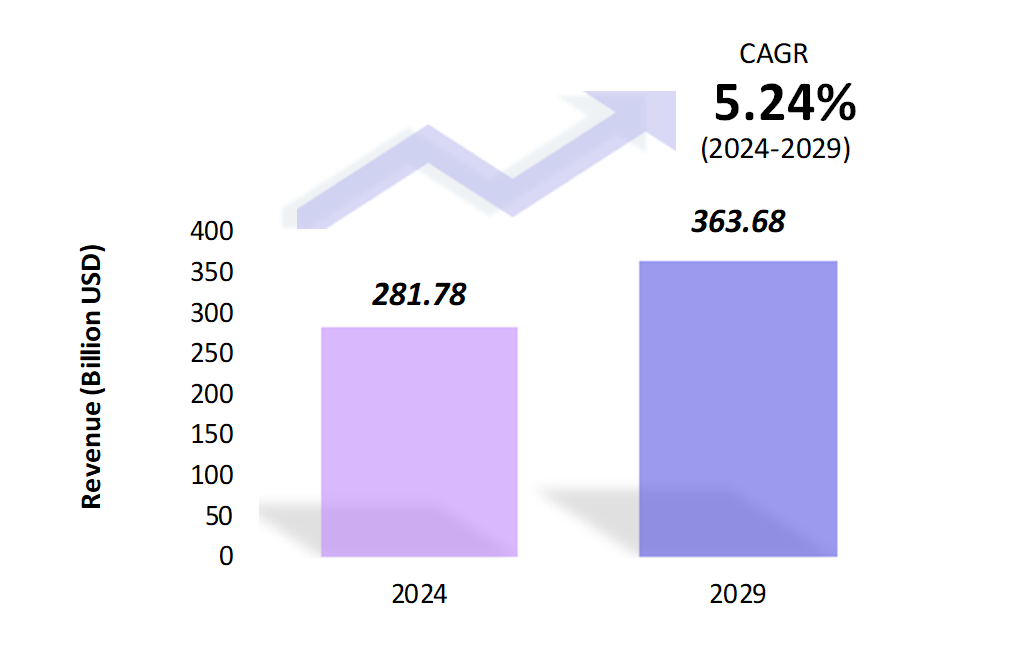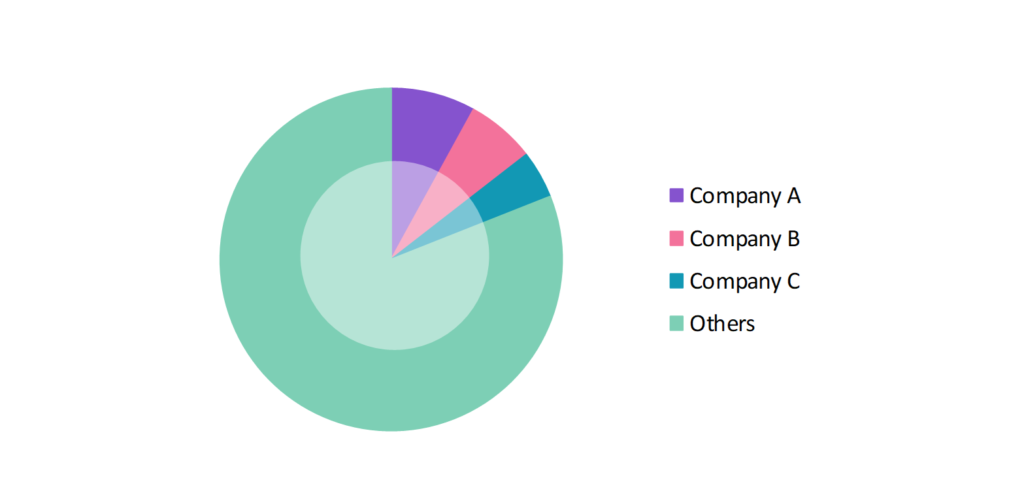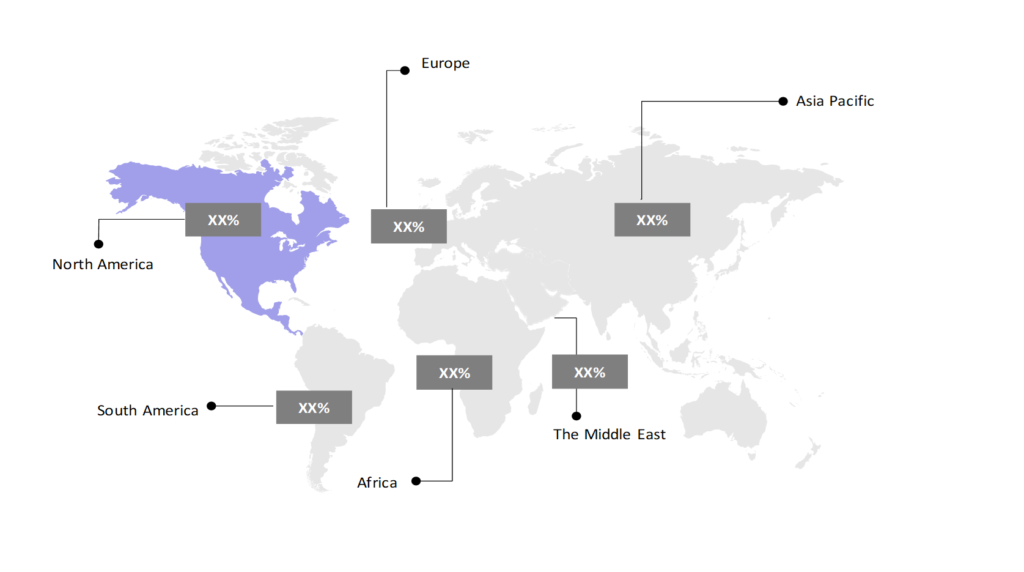Full-Service Carrier Market Insights: Size, Share, Growth Analysis & Forecast (2024 – 2029)
The full-service carrier market report offers a detailed analysis segmented by Service (Meals, Beverages, In-flight Entertainment, Others); by Application (International Aviation, Domestic Aviation); by Geography (North America, South America, Asia Pacific, Europe, The Middle East, Africa).
Outlook

- The full-service carrier market is estimated to be at USD 281.78 Bn in 2024 and is anticipated to reach USD 363.68 Bn in 2029.
- The full-service carrier market is registering a CAGR of 5.24% during the forecast period 2024-2029.
- The full-service carrier (FSC) market caters to premium passengers by offering comprehensive travel experiences, including in-flight meals, checked baggage, and premium services such as business class and first-class seating. The industry is recovering post-pandemic, with demand rebounding due to the resumption of international travel and increased vaccination rates.
Request a free sample.
Ecosystem

- The global full-service carrier industry participants are always developing strategies to preserve a competitive advantage.
- These focused on expanding its international routes and enhancing customer loyalty through its AAdvantage program, luxury experiences, sustainability initiatives, and investing heavily in digital transformation and sustainability.
- Several important entities in the full-service carrier market include Air China Ltd.; Air France-KLM; ANA Holdings Inc.; American Airlines Group Inc.; International Airlines Group; and others.
Ask for customization.
Findings
| Attributes | Values |
|---|---|
| Historical Period | 2018-2022 |
| Base Year | 2023 |
| Forecast Period | 2024-2029 |
| Market Size (2024) | USD 281.78 Bn |
| Market Size (2029) | USD 363.68 Bn |
| Growth Rate | 5.24% CAGR from 2024 to 2029 |
| Key Segments | Service (Meals, Beverages, In-flight Entertainment, Others); Application (International Aviation, Domestic Aviation); Geography (North America, South America, Asia Pacific, Europe, The Middle East, Africa) |
| Key Vendors | Air China Ltd.; Air France-KLM; ANA Holdings Inc.; American Airlines Group Inc.; International Airlines Group |
| Key Countries | The US; Canada; Mexico; Brazil; Argentina; Colombia; Chile; China; India; Japan; South Korea; The UK; Germany; Italy; France; Spain; Turkey; UAE; Saudi Arabia; Egypt; South Africa |
| Largest Market | North America |
Get a free quote.
Trends
- Shift Towards Smart Biometric Boarding: Full-service carriers are embracing digital solutions to improve the passenger experience. Airlines focus on contactless services, mobile check-ins, and AI-powered customer service. In 2022, Lufthansa launched its “Smart Boarding” project, which uses biometric technology for a seamless boarding experience.
- In-flight Wi-Fi and Entertainment: The emphasis on in-flight connectivity has been enhanced, leading FSCs to upgrade their entertainment systems. In 2023, American Airlines enhanced its Wi-Fi services across long-haul international flights, catering to tech-savvy travelers who expect constant connectivity.
- Emergence of Sustainability in Aviation: Environmental concerns prompt airlines to adopt greener practices. Many airlines emphasize fuel-efficient aircraft and exploring sustainable aviation fuels (SAFs) to reduce their carbon footprint and mitigate climate change.
Speak to analyst.
Catalysts
- Rising Demand for Premium Services: Full-service carriers increasingly benefit from the rising demand for premium travel experiences as more passengers seek the luxury and exclusivity of business and first-class services. This trend is enhancing revenue streams for these airlines, allowing them to offer enhanced amenities and superior customer service, further attracting affluent travelers.
- Emergence of Long-Haul Low-Cost Competition: While low-cost carriers (LCCs) present competition, the demand for full-service carriers remains strong, especially for long-haul flights where passengers prioritize comfort. In 2023, Qantas reported that despite competition, their long-haul flights were consistently fully booked, particularly for business travelers.
- Increasing International Tourism: As international borders reopen, the demand for leisure travel has surged. Full-service carriers (FSCs) are well-positioned to capture this increase due to their extensive global route networks and premium service offerings, which attract travelers seeking comfort and convenience. This strategic advantage enables FSCs to meet the growing needs of vacationers exploring new destinations effectively.
Inquire before buying.
Restraints
- Fuel Price Volatility: Fluctuating fuel prices remains a significant challenge for full-service carriers, as fuel constitutes a major portion of their operating expenses. This price volatility impacts their cost structures and profitability, necessitating fuel management and cost control strategies.
- Operational Costs and Inflation: Rising inflation and increasing operational costs, such as wages, fuel, and airport fees, are putting significant pressure on profit margins for full-service carriers (FSCs). These escalating expenses challenge airlines to maintain financial stability and profitability, compelling them to find innovative ways to manage costs while continuing to deliver high-quality service.
- Sustainability Regulations: Stricter environmental regulations push airlines to reduce their carbon footprint. The European Union’s “Fit for 55” plan, introduced in 2022, requires airlines to reduce emissions by 55% by 2030. Meeting these regulations requires FSCs to invest heavily in cleaner technologies, which can be costly.
Personalize this research.
Hotspot

Explore purchase options.
Table of Contents
| 1. Introduction 1.1. Research Methodology 1.2. Scope of the Study 2. Market Overview / Executive Summary 2.1. Global Full-Service Carrier Market (2018 – 2022) 2.2. Global Full-Service Carrier Market (2023 – 2029) 3. Market Segmentation 3.1. Global Full-Service Carrier Market by Service 3.1.1. Meals 3.1.2. Beverages 3.1.3. In-flight Entertainment 3.1.4. Others 3.2. Global Full-Service Carrier Market by Application 3.2.1. International Aviation 3.2.2. Domestic Aviation 4. Regional Segmentation 4.1. North America 4.1.1. The US 4.1.2. Canada 4.1.3. Mexico 4.2. South America 4.2.1. Brazil 4.2.2. Argentina 4.2.3. Colombia 4.2.4. Chile 4.2.5. Rest of South America 4.3. Asia Pacific 4.3.1. China 4.3.2. India 4.3.3. Japan 4.3.4. South Korea 4.3.5. Rest of Asia Pacific 4.4. Europe 4.4.1. The UK 4.4.2. Germany 4.4.3. Italy 4.4.4. France 4.4.5. Spain 4.4.6. Rest of Europe 4.5. The Middle East 4.5.1. Turkey 4.5.2. UAE 4.5.3. Saudi Arabia 4.5.4. Rest of the Middle East 4.6. Africa 4.6.1. Egypt 4.6.2. South Africa 4.6.3. Rest of Africa 5. Value Chain Analysis of the Global Full-Service Carrier Market 6. Porter Five Forces Analysis 6.1. Threats of New Entrants 6.2. Threats of Substitutes 6.3. Bargaining Power of Buyers 6.4. Bargaining Power of Suppliers 6.5. Competition in the Industry 7. Trends, Drivers and Challenges Analysis 7.1. Market Trends 7.1.1. Market Trend 1 7.1.2. Market Trend 2 7.1.3. Market Trend 3 7.2. Market Drivers 7.2.1. Market Driver 1 7.2.2. Market Driver 2 7.2.3. Market Driver 3 7.3. Market Challenges 7.3.1. Market Challenge 1 7.3.2. Market Challenge 2 7.3.3. Market Challenge 3 8. Opportunities Analysis 8.1. Market Opportunity 1 8.2. Market Opportunity 2 8.3. Market Opportunity 3 9. Competitive Landscape 9.1. Air China Ltd. 9.2. Air France-KLM 9.3. ANA Holdings Inc. 9.4. American Airlines Group Inc. 9.5. International Airlines Group 9.6. Company 6 9.7. Company 7 9.8. Company 8 9.9. Company 9 9.10. Company 10 |
Know the research methodology.
Full-Service Carrier Market – FAQs
1. What is the current size of the full-service carrier market?
Ans. In 2024, the full-service carrier market size is USD 281.78 Bn.
2. Who are the major vendors in the full-service carrier market?
Ans. The major vendors in the full-service carrier market are Air China Ltd.; Air France-KLM; ANA Holdings Inc.; American Airlines Group Inc.; International Airlines Group.
3. Which segments are covered under the full-service carrier market segments analysis?
Ans. The full-service carrier market report offers in-depth insights into Service, Application, and Geography.
